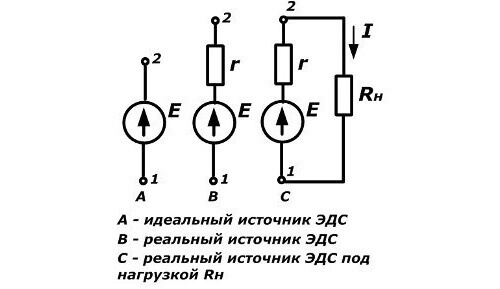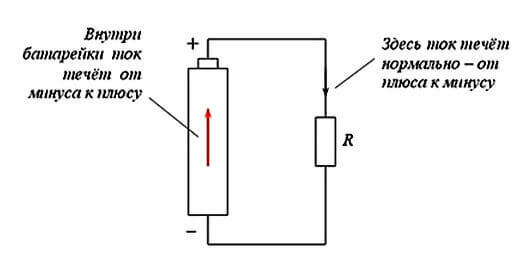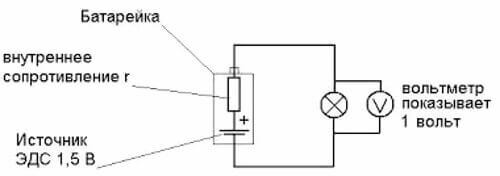Many people (including some electricians) confuse the concept of electromotive force (EMF) and voltage. Although these concepts are different. Despite the fact that they are insignificant, it is difficult for a non-specialist to understand them. The unit of measurement plays an important role in this. Voltage and EMF are measured in the same units - Volts. The differences do not end there, we talked about everything in detail in the article!
Content:
- What is electromotive force
- What is voltage
- So what's the difference
- Output
What is electromotive force
We examined this issue in detail in a separate article: https://samelectrik.ru/chto-takoe-eds-obyasnenie-prostymi-slovami.html
EMF is understood as a physical quantity that characterizes the work of any external forces located in power supplies DC or AC. Moreover, if there is a closed circuit, then we can say that the EMF is equal to the work of forces to move a positive charge to a negative one along a closed circuit. Or in simple terms, the EMF of a current source represents the work required to move a unit charge between the poles.

Moreover, if the current source has infinite power, and there is no internal resistance (position A in the figure), then the EMF can be calculated by Ohm's law for a chain sectionsince voltage and electromotive force in this case are equal.
I = U / R,
where U - voltage, and in the considered example - EMF.
However, a real power supply has finite internal resistance. Therefore, this calculation cannot be applied in practice. In this case, the formula for the complete circuit is used to determine the EMF.
I = E / (R + r),
where E (also denoted as "ԑ") - EMF; R is the load resistance, r is the internal resistance of the power supply, I is the current in the circuit.
However, this formula does not take into account the resistance of the circuit conductors. It should be understood that inside the DC source and in the external circuit, the current flows in different directions. The difference is that inside the element it flows from minus to plus, then in the external circuit from plus to minus.
This is clearly illustrated in the figure below:

In this case, the electromotive force is measured with a voltmeter, in the case when there is no load, i.e. the power supply is idling.
To find the EMF through the voltage and load resistance, you need to find the internal resistance of the source power supply, for this, the voltage is measured twice at different load currents, after which the internal resistance. Below is the procedure for calculating by the formulas, then R1, R2 are the load resistance for the first and second measurements, respectively, the remaining quantities are similar, U1, U2 are the source voltage at its terminals under load.
So, we know the current, then it is equal to:
I1 = E / (R1 + r)
I2 = E / (R2 + r)
Wherein:
R1 = U1 / I1
R2 = U2 / I2
If substituted in the first equations, then:
I1 = E / ((U1 / I1) + r)
I2 = E / ((U2 / I2) + r)
Now let's split the left and right sides into each other:
(I1 / I2) = [E / ((U1 / I1) + r)] / [E / ((U2 / I2) + r)]
After calculating with respect to the resistance of the current source, we get:
r = (U1-U2) / (I1-I2)
Internal resistance r:
r = (U1 + U2) / I,
where U1, U2 is the voltage at the source terminals at different load currents, I is the current in the circuit.
Then the EMF is equal to:
E = I * (R + r) or E = U1 + I1 * r
What is voltage
Electric voltage (denoted as U) is a physical quantity that reflects the quantitative characteristic of the work of an electric field in charge transfer from point A to point B. Accordingly, the voltage can be between two points of the circuit, but unlike the EMF, it can be between the two terminals of some of the circuit elements. Recall that EMF characterizes the work performed by outside forces, that is, the work of the current source itself or EMF to transfer charge through the entire circuit, and not on a specific element.
This definition can be expressed in simple terms. DC voltage is the force that moves free electrons from one atom to another in a specific direction.
For alternating current, the following concepts are used:
- instantaneous voltage is the potential difference between points in a given period of time;
- peak value - represents the maximum value modulo the instantaneous voltage value over a period of time;
- average value - constant voltage component;
- RMS and RMS.
The voltage of a section of a circuit depends on the material of the conductor, load resistance and temperature. As well as electromotive force is measured in Volts.
Often, to understand the physical meaning of stress, it is compared to a water tower. The column of water is identified with voltage, and the flow with current.
At the same time, the water column in the tower gradually decreases, which characterizes a decrease in voltage and a decrease in current strength.
So what's the difference
For a better understanding of what is the difference between electromotive force and voltage, consider an example. There is a source of electrical energy of infinite power, in which there is no internal resistance. A load is mounted in the electrical circuit. In this case, it will be true that the EMF and voltage are identically equal, that is, there is no difference between these concepts.
However, these are ideal conditions that do not occur in real life. These conditions are used exclusively for calculations. In real life, the internal resistance of the power supply is taken into account. In this case, EMF and voltage are different.

The figure shows what the difference will be in the values of the electromotive force and voltage in real conditions. The above formula for Ohm's law for a complete circuit describes all processes. With an open circuit, the battery terminals will have a value of 1.5 Volts. This is the EMF value. Having connected the load, in this case it is a light bulb, it will have a voltage of 1 volt.
The difference from an ideal source is the internal resistance of the power source. At this resistance, a voltage drop occurs. These processes are described by Ohm's law for a complete circuit.
If the measuring device at the terminals of the power source shows a value of 1.5 Volts, this will be an electromotive force, but we repeat, provided there is no load.
When the load is connected, the terminals will have a deliberately lower value. This is tension.
Output
From the above, we can conclude that the main difference between EMF and voltage is:
- The electromotive force depends on the power source, and the voltage depends on the connected load and the current flowing through the circuit.
- Electromotive force is a physical quantity that characterizes the work of external forces of non-electrical origin, occurring in DC and AC circuits.
- Voltage and EMF have a single unit of measurement - Volt.
- U is a physical quantity equal to the work of the effective electric field produced during the transfer of a single test charge from point A to point B.
Thus, briefly, if we represent U in the form of a column of water, then the EMF can be represented as a pump that maintains the water level at a constant level. We hope that after reading the article, the main difference has become clear to you!
Related materials:
- What is the difference between a transformer and an autotransformer
- Difference between contactor and starter
- How to know if there is voltage in the outlet

